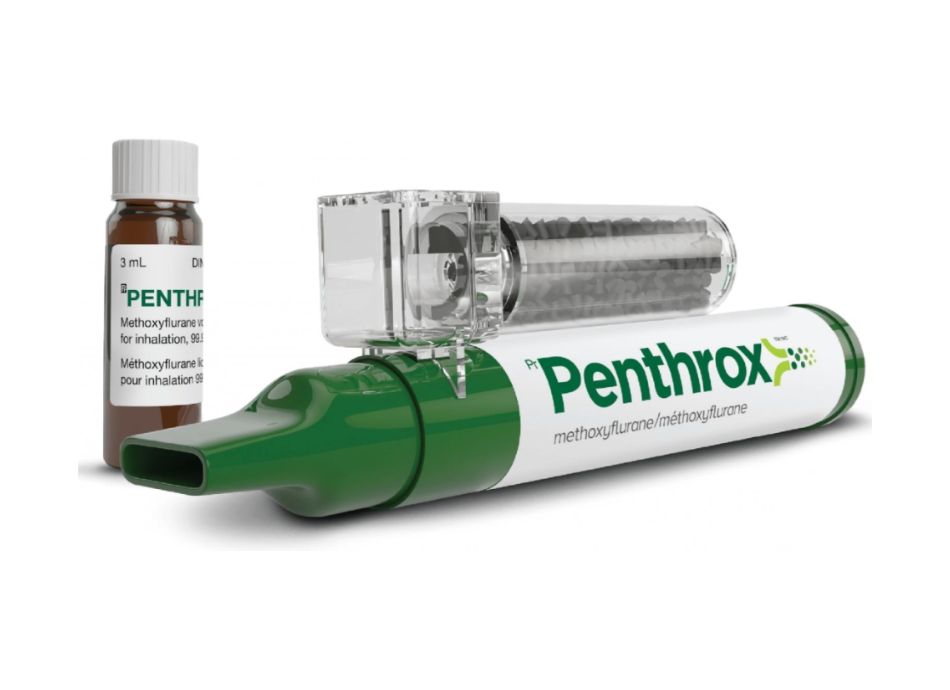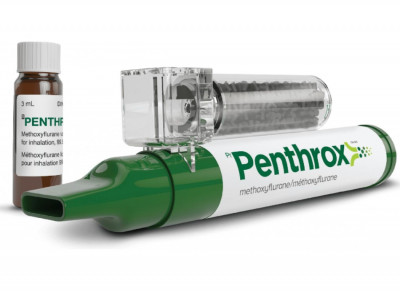Wishing everyone happy holidays and a joyful New Year from the Healthify team. Don't forget to Slip, Slop, Slap and Wrap!
Methoxyflurane
Sounds like 'meth-OX-ee-FLUR-ane'
Key points about methoxyflurane
- Methoxyflurane is used for the short-term relief of moderate to severe pain after injury or during certain medical procedures.
- Methoxyflurane is also called Penthrox®.
- It belongs to a family of medicines called inhalation anaesthetics.


Methoxyflurane is also called Penthrox®. It's used for the short-term relief of moderate to severe pain after injury or during some short medical procedures. It helps to reduce the pain, rather than stop it completely.
- Methoxyflurane is short acting, which means it quickly disappears from your body and usually has a short recovery time.
- Methoxyflurane is not used for long-term (chronic) pain or pain that goes away and keeps coming back.
- It belongs to a family of medicines called inhalation anaesthetics.
Image credit: Douglas NZ (with permission)
Methoxyflurane comes as a vapour which is breathed in through your mouth, using an inhaler device
- Methoxyflurane is in an inhaler that you breathe in so you have control of when to use it.
- It has a fruity taste and smell.
- There will always be a nurse or a doctor to supervise you using it.
- Instructions on how to use it are provided below – how to use methoxyflurane.
Tell your healthcare team if you have had a reaction to inhaled anaesthetics or if you have malignant hyperthermia
Methoxyflurane should not be used if you have malignant hyperthermia.
- Malignant hyperthermia is a rare, inherited condition that runs in families.
- For people with malignant hyperthermia, some anaesthetic medicines and gases can cause a very high fever, fast, irregular heartbeat, muscle spasms and breathing problems. It can be fatal if not treated quickly.
Your healthcare provider will show you how to use the inhaler. Here is some guidance.
- The inhaler is attached to a loop of fabric. Place the loop over your hand, on your wrist, so you can hold the inhaler yourself.
- Place the mouthpiece between your teeth with your lips closed around it.
- It's important to breathe in AND out through the mouthpiece of the inhaler. Inhale gently for the first few breaths and then breathe normally through the inhaler thereafter. Breathing out through the inhaler stops people around you breathing in the medicine.
- It usually takes 6 to 10 breaths before the medicine starts working.
- Note: Hold on to the inhaler yourself. It’s important that whānau or friends don’t help you with this.

Image credit: Douglas NZ (with permission)
Pain relief
- Once methoxyflurane has started working, you can breathe it in from time to time, occasionally, when you feel you need more pain relief.
- If you need stronger pain relief, there's a hole at the top of the inhaler, which can be closed with your finger to get a bigger dose.
- Pain relief will continue for several minutes after stopping methoxyflurane.
- You may feel a little light-headed or drowsy. If you become drowsy, you will be unable to hold the inhaler to your mouth which stops you from breathing the vapour and allows the effect to wear off. For this reason, it is important that you hold the inhaler yourself.
- Note: A 3 mL dose of methoxyflurane provides pain relief for about 20 to 30 minutes with continuous use, and for up to 1 hour with occasional use.
Monitoring while you are using the inhaler
While you are using methoxyflurane, your healthcare provider will monitor your heart rate, blood pressure, oxygen saturation, breathing rate (respiratory rate) and pain. Your health professional will ask you how you are feeling, and may ask you to rate your pain on a scale of 1 to 10.
After you have used methoxyflurane
The effects of methoxyflurane wear off very quickly and if you feel well, you should be able to go home soon after your procedure. However, sometimes you might need a bit more time to feel normal. Take care until the effects have completely worn off.
- Don't drive for at least 12 hours after having it, or as recommended by your health professional.
- Don't use tools or machines if you feel sleepy or dizzy.
- Take great care with everyday activities, eg, crossing the road or cooking.
Like all medicines, methoxyflurane can cause side effects, although not everyone gets them. Usually the side effects are mild and last only a short time.
| Side effects | What should I do? |
|---|---|
|
|
|
|
|
|
Read more about medicines and side effects and reporting a reaction you think might be a side effect.
References
- Methoxyflurane(external link) New Zealand Formulary
- Penthrox(external link) Medsafe Datasheet, NZ
Brochures

Medicines and side effects
Healthify He Puna Waiora, NZ, 2024

Health Quality and Safety Commission, NZ, 2019 English, te reo Māori
Credits: Sandra Ponen, Pharmacist, Healthify He Puna Waiora. Healthify is brought to you by Health Navigator Charitable Trust.
Reviewed by: Angela Lambie, Pharmacist, Auckland
Last reviewed:





